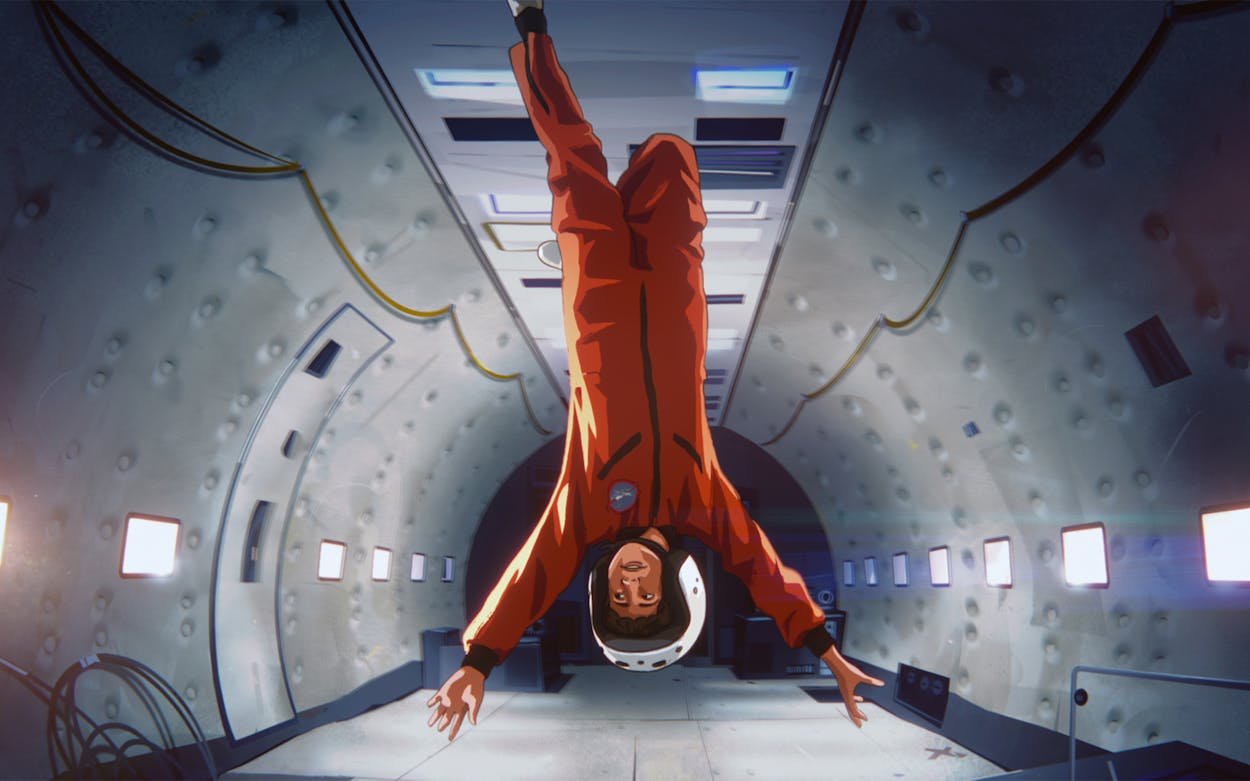Richard Linklater makes two kinds of movies: ones with stories and ones without. The story-heavy movies can be commercially successful—School of Rock was a massive hit that spawned a stage adaptation and a TV series—while the plot-light films (Boyhood, the Before series) tend to get him nominated for Oscars. There’s some crossover in the receptions of the two types of films, of course. Boyhood made a relative boatload of cash at the box office, while the more straightforward Last Flag Flying flopped. But making sense of his latest, the animated, space race–era period piece Apollo 10½: A Space Age Childhood—which premiered Sunday at SXSW, and which will hit Netflix April 1—requires accepting that Linklater is, ultimately, an experimental filmmaker who sometimes dabbles in commercialism, rather than a traditional storyteller whose movies occasionally meander.
As experimental films go, Apollo 10½ is more likable than many. It’s a pleasant, good-natured paean to nostalgia—Linklater’s, specifically, or that of anyone else who grew up white and middle-class around Houston in the late 1960s. There’s not a drop of conflict in it (even potential setups like “Will the protagonist’s family ride roller coasters at Astroworld or stay home to watch the moon landing?” get resolved within the scenes in which they’re introduced with a reassuring “There’ll be time to do both”), but that’s not where Linklater’s interest lies here. Instead, he’s focused on exploring a question along the lines of “How can you best re-create your own childhood on film?,” or maybe “What’s the best way to let memory wash over an audience?”
To that end, Linklater turns to animation, a medium he’s been successful with in earlier experiments—specifically, rotoscopic animation, in which a movie is shot live with actors, then traced over (originally by hand, now with computers) to create fluid, lifelike, somewhat-uncanny images. Linklater was the first to make an entire feature film that used digital rotoscoping, in 2001’s moody, philosophical treatise Waking Life (he did so again in 2006, with the more conventionally plotted A Scanner Darkly). Linklater’s success spawned a cottage industry around the technique, largely centered in Austin—the 2016 documentary Tower (based on a Texas Monthly story) was animated through rotoscoping, as was the 2019 Amazon series Undone. (Both were animated by Austin-based studio Minnow Mountain, which performed the same role on Apollo 10½.)

In Waking Life, Linklater used rotoscoping to create a level of remove between the audience and the performance—the animation made the movie feel dreamlike, familiar but not. In A Scanner Darkly, he deployed it to evoke an uncanny sense of hallucinatory paranoia. In Apollo 10½, the animation serves a different purpose. Here, Linklater is interested in the gauzy nature of memory, and the way that a recollection of the past differs from actual events.
That’s part of a theme Linklater’s played with throughout his career, in films both animated and not: time, and the unique ways film allows audiences to experience it. In some of his work, his application of time as a storytelling force is obvious, almost showy—Boyhood, famously, was shot over twelve years, with child actors who grew into young adults before the viewer’s eyes—while in others, it’s more subtle. Both Dazed and Confused and its spiritual successor, Everybody Wants Some!!, play heavily with the way nostalgia interacts with memory. (A 2020 exhibit in Paris on Linklater’s work was called “Le cinéma, matière-temps,” which translates to “Filming time as material.”)
In Apollo, time works differently. The movie takes place in and around 1969, though precisely how and when isn’t really important, except that it’s around the lead-up to the moon landing that summer. Linklater plays Apollo out less like a chronological narrative than like a protracted tour through a scrapbook. Every TV show that was in syndication that year, every song that one would hear on the radio, every meal that a household like his would eat for dinner, every ride at Astroworld is here, re-created in detail that ranges from sketchy to nearly photorealistic, depending on how closely Linklater’s stand-in character, Stanley (played by newcomer Milo Coy as a child, and voiced by a drawling Jack Black in narration throughout the film), recalls them.
How well all of that works is up to the viewer—if you’re interested in poring through Linklater’s cinematic scrapbook, then Apollo 10½ is lovely and tender. If you’re not as curious about what it was like to be a white, middle-class nine-year-old obsessed with the space race, then the movie is boring, and maybe a missed opportunity. (Linklater nods to the fact that not every American—especially Black and brown Americans who saw in their own communities needs that the money NASA got could have helped address—was infatuated with going to the moon, but doesn’t really engage with it.) But as with Linklater’s other experiments, the success of Apollo 10½ won’t ultimately be measured solely on whether the film is a critical success, or whether it finds a wider audience. The rotoscoping he helped pioneer in his early- and mid-aughts features was used to stunning effect in Tower and inspired the recent Oscar-nominated documentary Flee, giving filmmakers a tool to more ethically and honestly blur the lines between actual footage and re-creation. The broad, artistic use of time as a narrative force that Linklater utilized in Boyhood and the Before films presaged Hollywood’s obsession with revisiting old franchises like Cobra Kai or The Matrix by showing the lines on the original actors’ faces, rather than recasting. Apollo 10½ hits Netflix in a few weeks—but we may not know the extent to which the film has ultimately succeeded until we see what it leads other filmmakers to attempt.
- More About:
- Film & TV
- SXSW
- Space
- Richard Linklater
- Austin








